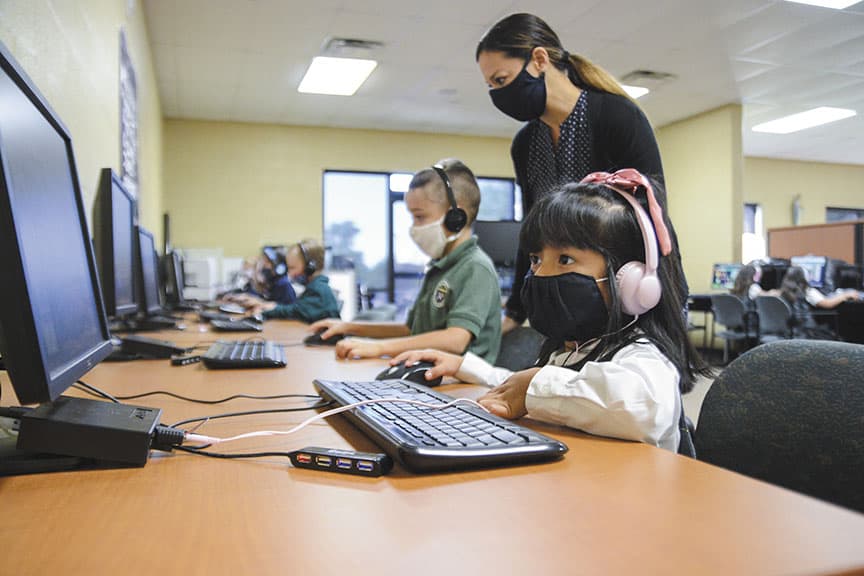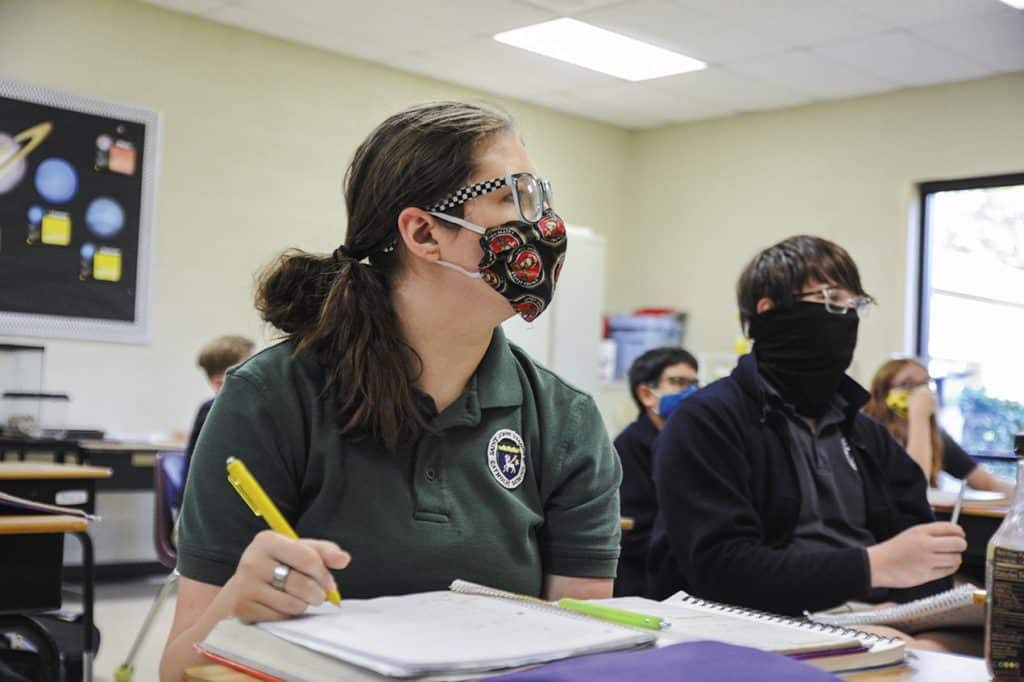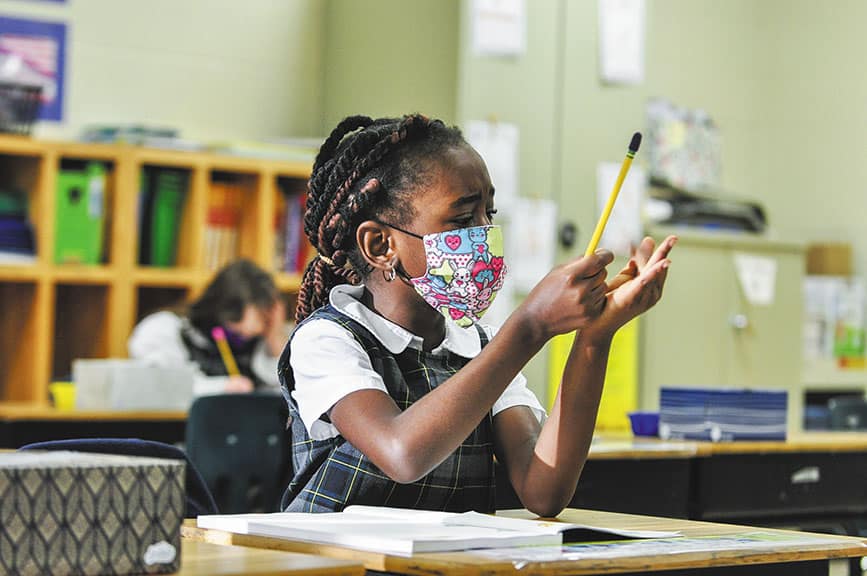
Catholic schools in the Diocese of Nashville have successfully completed the first quarter of the school year in the midst of the COVID-19 pandemic. There have been a few bumps along the way, but schools have been able to continue to meet the goal of offering in-person learning.
“They’ve done a very good job,” diocesan Superintendent of Schools Rebecca Hammel said of the schools’ efforts in following the protocols to prevent the spread of the coronavirus.
There have been confirmed cases of the coronavirus among students, faculty and staff that have prompted some classrooms in diocesan schools to go to distance learning temporarily, but they’ve been able to return to in-person learning, Hammel said.
“Fortunately, we have not had to do that in many cases,” she said.
Two independent Catholic schools in Nashville briefly transitioned entirely to distance learning because of their local circumstances but have returned to in-person learning.
St. Bernard Academy moved to distance learning from Sept. 21 through Oct. 2, which led into fall break, Oct. 5-9, after the school had seven confirmed cases reported, said Head of School Chuck Sabo. Students and faculty were back at school on Monday, Oct. 12.
“There was a lot of smiles,” Sabo said of the return of students, faculty and staff to the school building. “I think most of them were from the parents. They appreciate everything the teachers were doing.”
Besides the seven confirmed cases, St. Bernard had 70 students and 20 faculty and staff in quarantine, Sabo said. “It was an asymptomatic person that managed to get it into the building. It kind of took off after that,” he said.
“Once we had that exposure, we felt it was best to shut down for two weeks and come back after fall break,” Sabo said.
St. Cecilia Academy had a similar experience. After about 20 students and faculty tested positive, school officials decided to close the school building and move to distance learning for the eight days leading into fall break, Oct. 5-9, said Principal Sister Anna Laura, O.P.
“It’s not a crisis. It’s something we anticipated and prepared for,” she said.
“Our priority is in-person learning,” Sister Ann Laura said. “We took this action just so we can get back to in-person learning as soon as possible.”
Like all the Catholic schools in the diocese, St. Bernard and St. Cecilia started the school year with plans to implement distance learning if needed and were able to move quickly once the number of cases began to grow.
“Our teachers were ready, and our students were ready so we could do a quick regroup … and come back strong again,” Sister Anna Laura said.
“We have a remote learning plan in place. The teachers all came in to teach during those two weeks. The kids were remote. That was very effective in getting instruction out,” Sabo said.

The switch to distance learning went more smoothly because of the lessons learned when all the schools made that move last spring, Sabo said. “We found a really effective method. The teachers hit a groove with it and things worked out really well.”
It was a similar experience at St. Cecilia. “Now everyone is ready,” Sister Anna Laura said. “Our teachers are ready, our students are ready, so there’s not that element of the unknown.”
The Catholic Schools Office worked with principals and teachers all summer to prepare for moving back to in-person learning this fall, Hammel said, including developing protocols such as mask wearing, hand sanitizing, temperature checks, and social distancing.
“We wanted to make sure teachers had all the personal protective equipment they needed, that they were well versed in our safety protocols and that they were trained to recognize the COVID-19 symptoms,” said Hammel, who was a member of a Davidson County task force that developed a plan for reopening schools.
The Catholic Schools Office and the schools also worked on meeting the emotional needs of students who hadn’t been in a classroom between March and August, Hammel said.
“We were attuned to those needs of the students so when they did return, we could maximize the learning experience,” she said.

The first quarter was “amazing,” said Natalie Eskert, principal of St. John Vianney School in Gallatin. “We’ve thankfully had zero cases to report. We’ve been good. We’ve been since day one following our reopening plan and procedures.
“Students and families have been so cooperative following the protocols and making sure that we’re operating as safely as possible,” she added.
“We were all pretty optimistic and excited to be back in school,” Eskert said of the start of the new school year in August. “There were so many new protocols and procedures in place to be open safely. The initial task was making sure we were able to implement everything we promised to do. There were a lot of new things we were not all used to in a regular school setting.
“Once we opened and got into the routine of things, everything has been flowing smoothly,” Eskert said.
It’s been a similar story at St. Ann School. “Overall, we seem to be doing really well,” said Principal Anna Rumfola.
No student or staff member has tested positive for the virus, though three families have held their children out of school because of a possible exposure, Rumfola said. “Parents have been great at communicating if they feel there’s been a possible exposure.”
“Most of them get a test and once they get a negative test, they come back to school,” she said. “We’ve been lucky. We haven’t had a direct exposure at school.”
“It’s a lot of work to make sure everyone stays on task with frequent hand washing and wearing the masks,” Sabo said. “But even our 3-year-olds are doing well with the masks.”
There was some concern that students might have fallen behind academically because they were out of the classroom for so long. All the diocesan elementary schools administered the Iowa Assessments early in the year to see if there were any gaps in academic achievement.
“Overall, our students performed very well. We didn’t see large gaps in learning,” Hammel said. She attributed the successful performance on the standardized tests to the work of the teachers last spring.
“I had faith in the teachers that they were meeting their standards even though they didn’t have the opportunity to do it in person,” said Eskert, who is in her first year at St. John Vianney.
Although all the schools opened with in-person learning, most were able to offer distance learning for families who felt more comfortable keeping their children at home.
At St. Bernard, the school year started with about 70 students opting for that choice, Sabo said. Since the start of the school year, that number has fallen to about 60 as families decided to send their children to school.
“It’s hard for the teachers,” Sabo said. “They’re basically working off two teaching plans.”
But it’s also prompted schools to use their online lessons and tools as part of their in-person instruction.
“We are definitely integrating technology more than ever,” said Eskert, where the number of students who chose distance learning has dropped from five or six at the beginning of the year to three now.
“We have adopted the entire Google for Education platform and we most definitely plan to use it going forward,” Eskert said. “They have a lot of innovative learning tools that can be used in the classroom.”
Several schools have seen an increase in enrollment since the start of the school after parents could assess whether the preventive measures the schools were taking were successful.
Since opening day, the total enrollment of students in diocesan schools has increased by 57, which is a 1.25 percent increase.
The Schools Office and the schools in the diocese continue to watch the number of coronavirus cases reported in their communities. “We know the virus is still present,” Hammel said. “We continue to be vigilant.”









